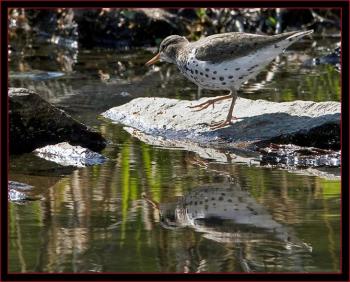The stuff of legends
It’s the stuff of legends: a society in which a female maintains a harem of males who take on all child-rearing duties while she patrols the home turf to prevent other females from coming in and hanging around any of her males.
You may find it hard to believe, but this kind of thing is taking place right here in Midcoast Maine. And they aren’t making any special effort to hide it!
The society we are talking about is that of the spotted sandpiper, one of a handful of birds that are known as polyandrous: meaning, the female mates with multiple males while the males mate with only one female.
Spotted sandpipers are found along the shores of oceans, rivers, lakes and marshes across most of North America. In fact, they have the most widely distributed breeding range of any North American shorebird. Although their breeding plumage is spotted below, their most distinctive identifying feature is probably their behavior.
Spotted sandpipers constantly tip their bodies back and forth like a teeter-totter as they walk around looking for small invertebrates on the shore. And when they fly, the wings are held in a stiff arch and flicked downward, a flight pattern unlike any other shorebird.
The females are the first to arrive on the breeding grounds where they establish a territory along a shoreline and drive off other females. When the males arrive, the females begin courting them with display flights.
Males that are enticed to mate will then incubate and tend to the three to four eggs that the female lays in a simple depression on the ground. Females may have anywhere from one to five males on nests within their territory.
Males defend smaller sub-territories within the larger territory of the female, even defending their space against other males that are mates of the same female.
The eggs take longer to hatch than in songbirds, around 21 days versus only 10-14 in small songbirds, but the young are born feathered and able to walk and feed themselves within hours of hatching. The male will watch over them, brooding them at night and under cold or rainy conditions and trying to protect them from predators.
In the fall, spotted sandpipers migrate south, usually staying no later than October, and can be found over much of South and Central America and the Caribbean but some as far north as the southern United States.
Watch for them at a shoreline near you; but don’t be shocked by their surprising life history!
Dr. Jeff Wells is the senior scientist for the Boreal Songbird Initiative. During his time at the famed Cornell Lab of Ornithology and as the Audubon Society's national bird conservation director, Dr. Wells earned a reputation as one of the nation's leading bird experts and conservation biologists. Jeff's grandfather, the late John Chase, was a columnist for the Boothbay Register for many years. Allison Childs Wells, also formerly of the Cornell Lab of Ornithology, is a widely published natural history writer and a senior director at the Natural Resources Council of Maine. Together, they have been writing and teaching people about birds for decades. The Maine natives are authors of the highly acclaimed book, “Maine's Favorite Birds.”






























